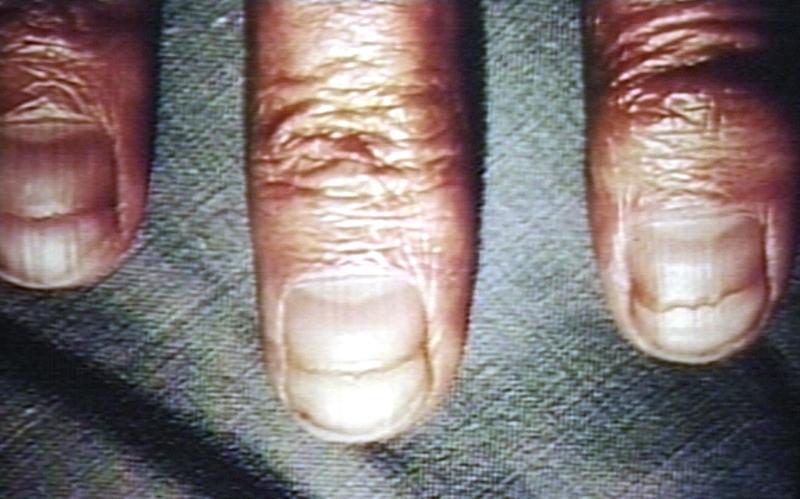Beau's lines
| Beau's lines | |
 | |
|---|---|
| ICD-10 | L60.4 |
| ICD-9 | 703.8 |
| DiseasesDB | 30839 |
|
WikiDoc Resources for Beau's lines |
|
Articles |
|---|
|
Most recent articles on Beau's lines Most cited articles on Beau's lines |
|
Media |
|
Powerpoint slides on Beau's lines |
|
Evidence Based Medicine |
|
Clinical Trials |
|
Ongoing Trials on Beau's lines at Clinical Trials.gov Clinical Trials on Beau's lines at Google
|
|
Guidelines / Policies / Govt |
|
US National Guidelines Clearinghouse on Beau's lines
|
|
Books |
|
News |
|
Commentary |
|
Definitions |
|
Patient Resources / Community |
|
Patient resources on Beau's lines Discussion groups on Beau's lines Patient Handouts on Beau's lines Directions to Hospitals Treating Beau's lines Risk calculators and risk factors for Beau's lines
|
|
Healthcare Provider Resources |
|
Causes & Risk Factors for Beau's lines |
|
Continuing Medical Education (CME) |
|
International |
|
|
|
Business |
|
Experimental / Informatics |
Editor-In-Chief: C. Michael Gibson, M.S., M.D. [1]
Overview
Beau's lines are deep grooved lines that run from side to side on the fingernail. They may look like indentations or ridges in the nail plate that could be a sign of stress. Beau's lines are the result of a temporary cessation of cell division in the nail matrix, and they are associated with many serious conditions.
Historical Perspective
This condition of the nail was named by a French physician, Joseph Honoré Simon Beau (1806–1865), who first described it in 1846.
Causes
Causes by Organ System
| Cardiovascular | Coronary occlusion, Shock |
| Chemical / poisoning | No underlying causes |
| Dermatologic | Dermatologic disorders |
| Drug Side Effect | Multiple underlying causes, most notably chemotherapy |
| Ear Nose Throat | No underlying causes |
| Endocrine | Diabetes |
| Environmental | No underlying causes |
| Gastroenterologic | No underlying causes |
| Genetic | No underlying causes |
| Hematologic | No underlying causes |
| Iatrogenic | No underlying causes |
| Infectious Disease | Severe infectious disease |
| Musculoskeletal / Ortho | No underlying causes |
| Neurologic | Delirium, Depression |
| Nutritional / Metabolic | Malnutrition |
| Obstetric/Gynecologic | No underlying causes |
| Oncologic | Chemotherapy |
| Opthalmologic | No underlying causes |
| Overdose / Toxicity | Chemotherapy, Toxins |
| Psychiatric | Delirium, Depression |
| Pulmonary | No underlying causes |
| Renal / Electrolyte | Hypocalcemia |
| Rheum / Immune / Allergy | Reiter's disease, Gout |
| Sexual | No underlying causes |
| Trauma | Trauma in general and to the nail in particular |
| Urologic | No underlying causes |
| Miscellaneous | Deep sea diving, Surgery |
Causes in Alphabetical Order
- Aging
- Arthritis
- Chemotherapy particularly cytotoxic agents
- Coronary occlusion
- Delirium
- Depression
- Dermatologic disorders
- Diabetes
- Drugs
- Gout
- Hypocalcemia
- Infection
- Iron deficiency
- Malnutrition
- Reiter's Disease
- Severe infectious disease
- Shock
- Stress
- Surgery
- Toxins
- Trauma
- Traumatic damage to nail matrix
Diagnosis
Physical Examination
Beau's lines should be distinguished from Muehrcke's lines of the fingernails. While Beau's lines are actual ridges and indentations in the nail plate, Muehrcke's lines are areas of hypopigmentation without palpable ridges.
Research
A researcher found Beau's lines in the fingernails of 6 divers following a deep saturation dive to a pressure equal to 335 meters of sea water, and in 2 of 6 divers following a similar dive to 305 meters.[1]
References
- ↑ Schwartz H., "Clinical observation: Beau's lines on fingernails after deep saturation dives", Journal of Undersea Hyperbaric Medicine (2006) Vol 3 No 1. pp 5-10.
External links
Template:Eponymous medical signs for integumentary and musculoskeletal systems